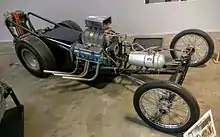Front engine dragster
The front engine dragster is a type of racing car purposely built for drag racing. Commonly known as a "rail", "digger", or "slingshot", it is now considered obsolete, and is used only in nostalgia drag racing. Wheelbases ranged from 97 to 225 inches (2,464 to 5,715 mm).[1]

History
The front engine dragster came about due to engines initially being located in the car's frame in front of the driver. They did not use (and current dragsters still do not use) any form of suspension. Because of this, these types of vehicles were prone to becoming unstable at speed. This is due to their making 2,000–3,000 hp (1,491–2,237 kW), plus having poor tire technology, short wheelbases, and very lightweight. (This was demonstrated to extremes in Fuel Altereds.) The driver sits angled backward, over the top of the differential in a cockpit situated between the two rear tires, a design originating with Mickey Thompson in 1954, as a way of improving traction.[2] This position led to many drivers being maimed when catastrophic clutch failures occurred.[3]
Introduced with the start of organized drag racing, they were limited by the availability of traction from their rear tires or "slicks". A number of dragsters with four rear drive wheels were attempted as well, including cars by Art Chrisman (along with his brother, Lloyd, and partner Frank Cannon), Bill Coburn,[4] and Eddie Hill.[5] (Coburn and the Chrisman brothers used twin engines, also.)[4]
Push starts were necessary until National Hot Rod Association (NHRA) mandated self-starters in 1976.[6] After burnouts, cars would be pushed back by crews; this persisted until NHRA required reverse gears in 1980.[6]
The slingshot produced a number of fatal wrecks in the 1960s, including Mike Sorokin's and John Mulligan's (months after suffering severe burns in a fire at the Nationals in 1969). Clutches, bell housings, blowers, and engines exploded, with e.t.s hitting 6.43 seconds by the end of 1969, a pass recorded by Mulligan to qualify #1 at the Nationals. Other accidents included a flip (what today would be called "blowover") by Jim Nicoll at the 1970 Nationals after a clutch failure.[7]
The slingshot's advantages, putting weight over the rear tires, now served to cause the front end to lift, as tire technology improved, to the point ballast, sometimes hundreds of pounds' worth, had to be added over the front axle,[8] while others, like Ronnie Scrima (on his Scrimaliner) and Tony Nancy, would mount a winglet.[9]
The drawbacks led to several attempts at rear-engined cars, but the rail was only supplanted by the rear-engined type (which is now standard) when Don Garlits introduced Swamp Rat XIV in 1971.[10] He designed the car while in hospital, having suffered from severe injuries caused by an exploding clutch.[3]
References
- Taylor, Thom. "Beauty Beyond the Twilight Zone" in Hot Rod, April 2017, pp.30-43 passim.
- Hot Rod. Dec 1986. p. 29. Missing or empty
|title=(help) - Levy, Art (3 October 2012). "Florida Icon: Don 'Big Daddy' Garlits". Florida Trend. Retrieved 21 March 2014.
- Hot Rod. Jul 1990. p. 143. Missing or empty
|title=(help) - "Hill, Eddie - Drag Racing - 2002". Motorsports Hall of Fame of America. Retrieved 3 February 2013.
- Burgess, Phil, ed. (3 March 2008). "Obsolete skills, part 1: On the track". National Dragster. US: NHRA. Retrieved 22 September 2018.
- NHRA.com (retrieved 24 May 2017)
- NHRA.com (retrieved 24 May 2017)
- Taylor, Thom. "Tony Nancy T/F dragster" and "Scrima, Bacilek, Milodon Scrimaliner", in "Beauty Beyond the Twilight Zone", pp.32 & 38.
- Hot Rod. Dec 1986. p. 28. Missing or empty
|title=(help)
